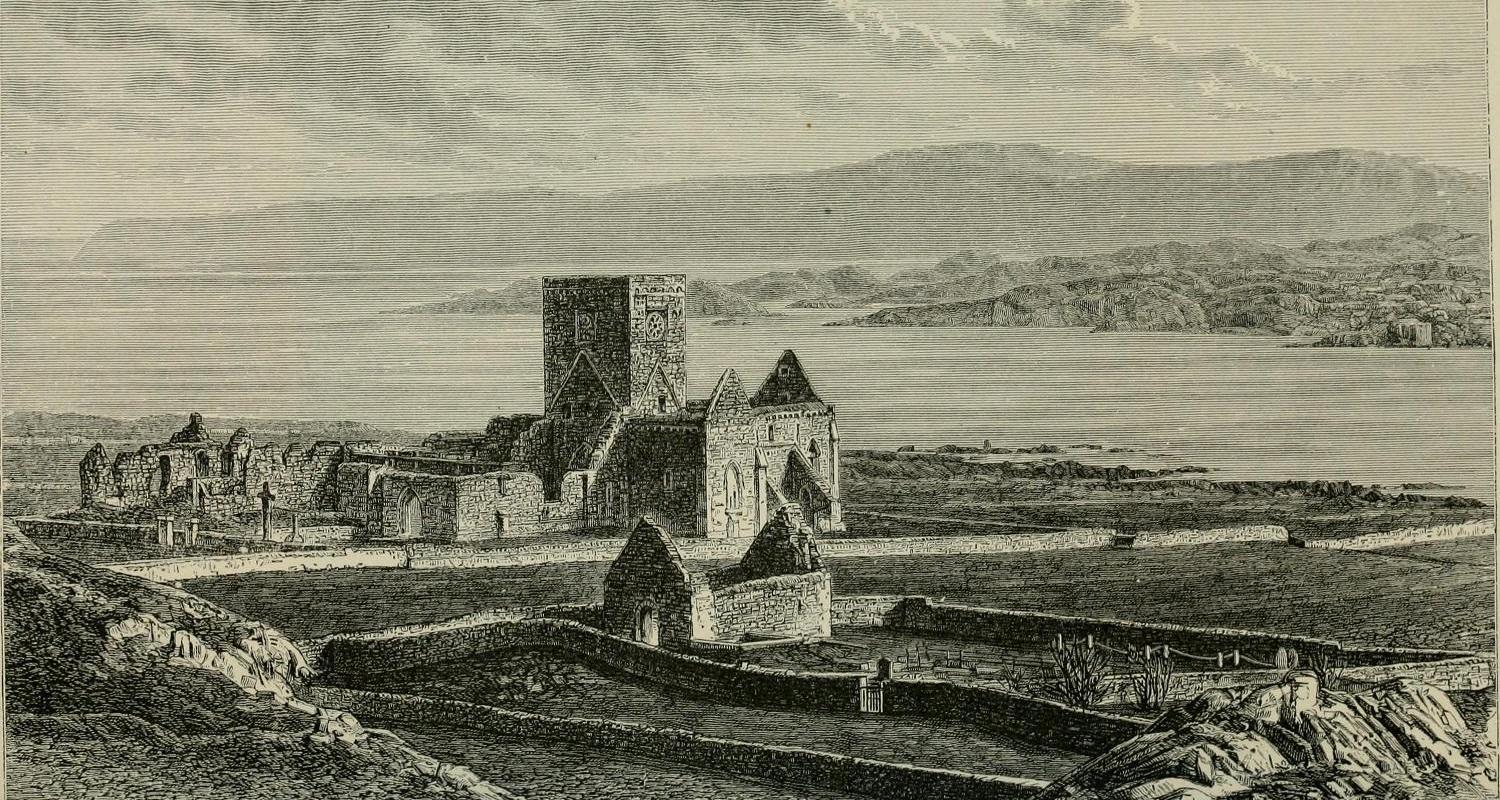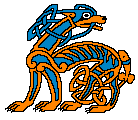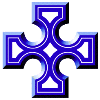The Abbots of Iona
A list of the Abbots of Iona from the earliest days.

Let us first be sure of the most ancient name of the island which has for so many generations been a place of dreams for the Scottish nation. It should also be understood that Iona was a holy place long before St Columba arrived from Ireland.
Iona is most anciently known as Ioua, its ancient Gaelic or Pictish name. This is the name invariably used by Adamnán, the ninth abbot, writing at the end of the seventh-century. It takes little to imagine a sleepy scribe erroneously copying a "n" for a "u" and turning Ioua into Iona! In modern Gaelic it is called I or Hy (pronounced ee), which simple form means island.
In the fifth century the Druids are supposed to have come here to escape the persecution of the armies of Imperial Rome, and to have founded a library on the island. It is said that in 410AD, when Fergus II (Fergus Mór mac Eirc), King of Dál Riata, became an ally of Alaric the Goth (d.410AD), he added to the library on Ioua by bringing back books that Alaric had 'obtained' after the plunder of Rome c.408-410AD. {This is a 'difficult' piece of history since Fergus is thought by most sources to have been born c.426AD} But it does suggest very strongly that Ioua was an established place of learning well before Columba arrived! Another name for the island is Innis nam Druineach, meaning 'the Island of the Cunning Workmen, or sculptors'; and still another is Innis-nam-Druidneach, 'the Isle of Druids.'
More than twenty years before Columba came to Iona, a Christian cemetery was founded on the island by St Oran of Letteragh, who died in 548AD. This Reilig Odhrain was the burial place of all of the kings of Dalriada up to 560AD, three years before Columba's arrival with his twelve followers. There is also a tradition that there was a college of seven bishops on the island and that two of them met Columba when he arrived from Ireland and did their best to persuade him not to land! Bishops in the Early Church in these parts had no territorial or diocesan powers and were subject to the authority of the ab (the old term for abbot) of the community where they were living at the time. They were simply required to provide episcopal functions such as ordination. Many of the community would not be ordained and they did not dedicate their churches in the modern sense, so the bishops were much more limited in their functions than is the case in the Medieval Church.
The succession of abs which follows starts with Colum-Cille (St Columba) himself.

| 547 - 597 | St Columba. Died 9 June 597. |
| 597 - 600 | Baithéne mac Brénaind. Colum Cille's devoted servant, cousin and successor as ab of the community. During Columba's lifetime Baithéne had charge of the daughter houses of Hinba, and Mag Luinge in Tiree. He is said to have been an accomplished scribe and was selected by Columba before his death to finish the Psalter he himself had started. Died 9 June 598. |
| 600 - 605 | Lasrén Mac Feradaig. During Colmba's time as ab, Lasrén was in charge of the daughter community at Durrow. He was the son of a cousin of Columba. Died 16 September 605. |
| 605 - 623 | Fergnae. The first ab not to be a blood-relation of Colum Cille. He is said to have had some British blood. Died 2 March 623. |
| 623 - 652 | Ségéne. He was the nephew of Lasrén mac Feradaig. Died 12 August 652. |
| 652 - 657 | Suibhne moccu Urthri. Died 11 January 657. |
| 657 - 669 | Cumméne Find. A nephew of ab Ségéne. Visited Ireland in 661AD. Died 24 February 669. |
| 669 - 679 | Fáilbe mac Pípáin. Third cousin of Cumméne. He spent from 673 to 676AD in Ireland. Died 22 March 679. |
| 679 - 704 | Adomnán - biographer of St Columba. He was ab at the time of the Synod of Whitby and, although he converted to the Roman ways himself he was unable to persuade his community on Hy to follow suit. Died 23 September 704. |
| 704 - 710 | Conamail mac Fáilbe. Died in 710AD, but we learn that Dunchad had already become abb in 707 and continued until his death in 717AD. There is known to have been a schism on Iona in 704 and that there were, consequently, and to 772AD, times when there were two rival abbs. The schism was the result of the attempt to 'convert' Iona to the Roman ways. Conamail died 11 September 710. |
| 707 - 717 | Dunchad. Died 25 May 717. |
| 713 - 713 | Dorbbéne. Died Saturday 28 October 713 having had the primacy for only five months. |
| 716 - 724 | Fáelchú. He received the chair of St Columba at the age of seventy-three on Saturday 29 August 716AD. Died as ab in 724AD. |
| 722 - __? | Fedlimid. Before Fáelchú died in 724AD, the annals record that Fedlimid became ab, but his death is not recorded. It would seem that he was installed alongside Dunchad - perhaps because of the latter's great age and infirmity, but see Conamail above. |
| 724 - 726 | Cilléne Fota. (Cilléne the Tall). Died in 726. |
| 726 - 752 | Cilléne Droichtech. (Cilléne the Bridgemaker.) Died 752. |
| 752 - 767 | Slébine mac Congaile. Was in Ireland in 754AD. Resigned before 766AD. Died 767. |
| 767 - 772 | Suibne. Resigned 771AD. Died 801. |
| 772 - 801 | Bresal. He is known to have visited Ireland in 778AD. Died 801. |
| 801 - 802 | Connachtach. ("Scriba selectisimus".) Died 802. |
| 802 - 814 | Cellach. Built Kells church in Ireland. Resigned 814AD.Died 815. |
| 814 - 832 | Diarmait. Carried St Columba's relics to Ireland in 830AD. Resigned 831AD. Died in or after 831. |
| 832 - 854 | Innrechtach. Slain by Saxons (possibly at Glastonbury) on his way to Rome 12 March 854. |
"An I mo chridhe, I mo ghráidh,
An áite guth mhanach bidh geum bá;
Ach mu'n tig an savghal gu crich,
Bithidh I mar a bha."
{The translation is at the foot of this page.}
| The following continuation is only suggested since much information is fragmentary. |
| Cellach mac Ailello. Removed St Columba's shrine to Ireland. Died 865. |
| Feradach McCormaic. Died 879. |
| Flaun McMaleduin. Died 20 April 891. |
| Maelbrigid. Abbot of Armagh. Died 927. |
| Aongas McMuircert. Died 935. |
| Dubtach. Died 938. |
| Caonconichrae. Died 945. |
| Robhartach. Died 954. |
| Duibduin. Died 959. |
| Finghin. Bishop, died 966. |
| Fiachra. Died 977. |
| Mugron. This abbot and 15 monks were slain by the Danes on Christmas Eve, 985. |
| Maelciarin. Murdered by the Dublin Danes, 986. |
| Dunchad. Died 989. |
| Dubdalethe. Abbot of Armagh, died 996. |
| Maelbrigid. (Maolbrid O'Rimedha) Died 1005. |
| Muredach Resigned 1007. "Muredach O'Crican, successor of Columba and Reader of Armagh, died 1011." |
| Flanobra (Flannabhra). Died 1025. |
| MacNia O'Uachtan. Was drowned in going to Ireland from Scotland, along with the books (bed?) of St Columba, three relics of St Patrik, and thirty men. |
| 1025 Malmore |
| 1040 Robharbach. |
| 1057 Gillechrist O'Maddor (O'Maldor). Died 1062. He was comharb of Colaimcille in Ireland and Scotland. |
| 1069 the abbot of Iona called "the son of McBaeten", was killed by the son of Indabar O'Maoldor. |
| 1099 Dunchad Mac Mic Maonach ("the son of the monk's son"), abbot of Iona, died. |
"In Iona of my heart, Iona of my love,
Instead of the vioce of monks shall be lowing of cattle;
But ere the world come to an end
Iona shall be as it was."
{Attributed to St Columba himself.}
 Return to top of page
Return to top of page